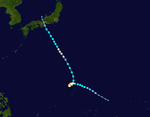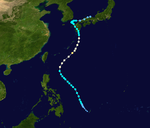1949 Pacific typhoon season
| 1949 Pacific typhoon season |

Season summary map
|
| Seasonal boundaries |
| First system formed |
January 13, 1949 |
| Last system dissipated |
December 14, 1949 |
| Strongest storm |
|
| Name |
Allyn |
| • Maximum winds |
230 km/h (145 mph)
(1-minute sustained) |
| • Lowest pressure |
884 hPa (mbar) |
|
| Seasonal statistics |
| Total depressions |
34 |
| Total storms |
22 official, 6 unofficial |
| Typhoons |
14 |
| Total fatalities |
At least 1,790 |
| Total damage |
> $127 million (1949 USD) |
| Related articles |
|
|
Pacific typhoon seasons
1947, 1948, 1949, 1950, 1951
|
| Typhoon (JMA) |
| Category 2 typhoon (SSHWS) |
|
|
| Duration |
January 13 – January 20 |
| Peak intensity |
155 km/h (100 mph) (1-min) 970 hPa (mbar) |
| Typhoon (JMA) |
| Category 3 typhoon (SSHWS) |
|
|
| Duration |
June 16 – June 22 |
| Peak intensity |
185 km/h (115 mph) (1-min) 952 hPa (mbar) |
| Typhoon (JMA) |
| Tropical Storm (SSHWS) |
|
|
| Duration |
July 4 – July 11 |
| Peak intensity |
95 km/h (60 mph) (1-min) 984 hPa (mbar) |
| Typhoon (JMA) |
| Category 2 typhoon (SSHWS) |
|
|
| Duration |
July 11 – July 18 |
| Peak intensity |
165 km/h (105 mph) (1-min) 942 hPa (mbar) |
| Typhoon (JMA) |
| Category 3 typhoon (SSHWS) |
|
|
| Duration |
July 18 – July 26 |
| Peak intensity |
205 km/h (125 mph) (1-min) 934 hPa (mbar) |
| Typhoon (JMA) |
| Category 3 typhoon (SSHWS) |
|
|
| Duration |
July 19 – July 29 |
| Peak intensity |
205 km/h (125 mph) (1-min) 966 hPa (mbar) |
| Tropical Storm (JMA) |
| Tropical Storm (SSHWS) |
|
|
| Duration |
July 25 – July 30 |
| Peak intensity |
95 km/h (60 mph) (1-min) 985 hPa (mbar) |
| Typhoon (JMA) |
| Category 2 typhoon (SSHWS) |
|
|
| Duration |
August 8 – August 19 |
| Peak intensity |
155 km/h (100 mph) (1-min) 964 hPa (mbar) |
| Typhoon (JMA) |
| Category 3 typhoon (SSHWS) |
|
|
| Duration |
August 28 – September 1 |
| Peak intensity |
205 km/h (125 mph) (1-min) 952 hPa (mbar) |
The 1949 Pacific typhoon season is an event in the annual cycle of tropical cyclone formation, in which tropical cyclones form in the western Pacific Ocean. The season runs throughout 1949, though most tropical cyclones typically develop between May and October. The scope of this article is limited to the Pacific Ocean to the north of the equator between 100°E and 180th meridian. Within the northwestern Pacific Ocean, there are two separate agencies that assign names to tropical cyclones which can often result in a cyclone having two names. The Japan Meteorological Agency (JMA) will name a tropical cyclone should it be judged to have 10-minute sustained wind speeds of at least 65 km/h (40 mph) anywhere in the basin, whilst the Philippine Atmospheric, Geophysical and Astronomical Services Administration (PAGASA) assigns names to tropical cyclones which move into or form as a tropical depression in their area of responsibility located between 135°E and 115°E and between 5°N–25°N regardless of whether or not a tropical cyclone has already been given a name by the JMA. Tropical depressions that are monitored by the United States' Joint Typhoon Warning Center (JTWC) are given a number with a "W" suffix.
In July, tropical storm Irma killed 1,600 people and destroyed more than 63,000 houses in Shanghai, China, the worst typhoon on record in the city.
Typhoon Gloria struck Okinawa on July 23. Gloria killed 38 people and destroyed 42,502 buildings on the island. Typhoon Gloria then continued westward and struck Shanghai, China killing 29 people.
Typhoon Kitty struck the Tokyo/Yokohama area August 31 through September 1, 1949. From reconnaissance reports the maximum sustained winds were near 110 knots 12 hours prior to landfall, but had fallen to minimum typhoon strength by the time it reached Honshū. The death toll reached 123 due to rainfall induced flooding and landslides (NY Times, 9/3/1949), and caused about 15 billion yen in damages. As its center passed near Tokyo, the JMA's Central Meteorological Office was able to launch eight rawindsondes in the typhoon environment. Researcher Dr. Hidedoshi Arakawa was able to analyize these soundings to make a vertical analysis of the storm.
...
Wikipedia










